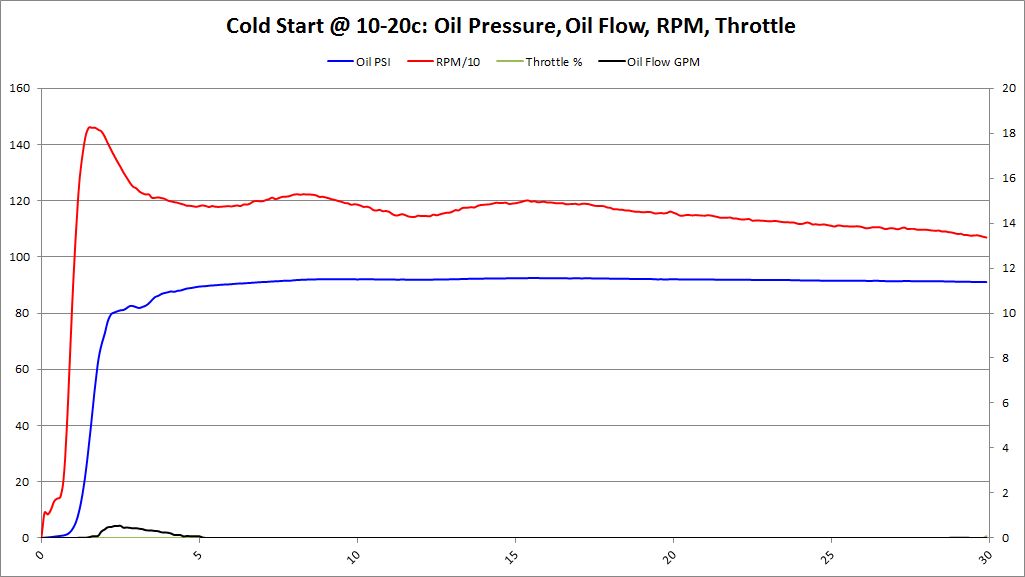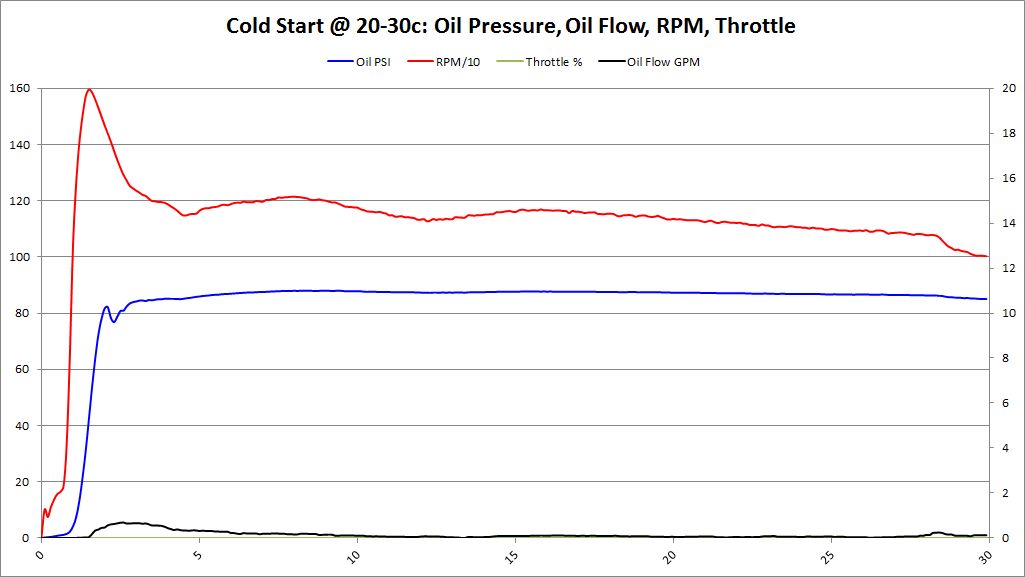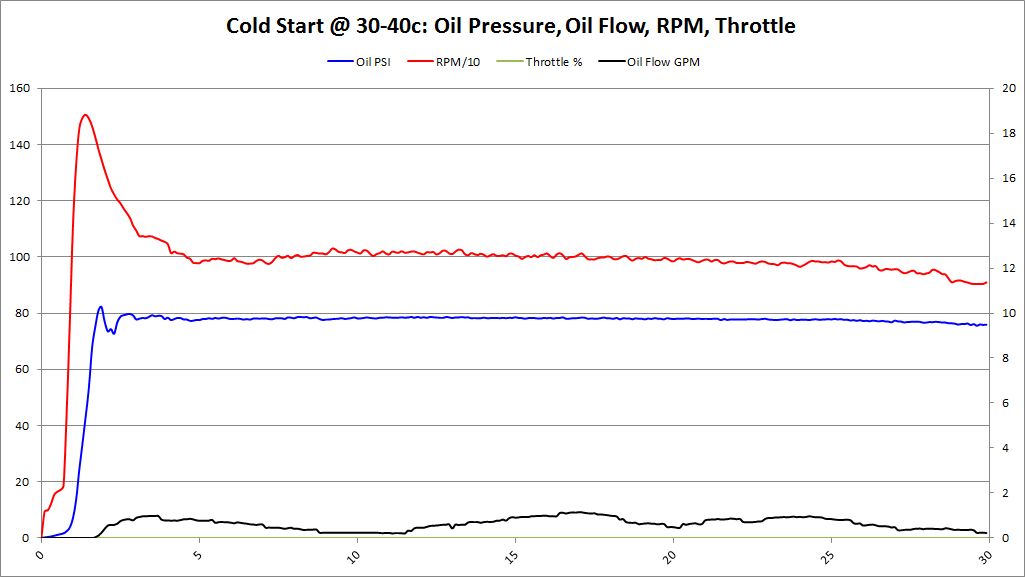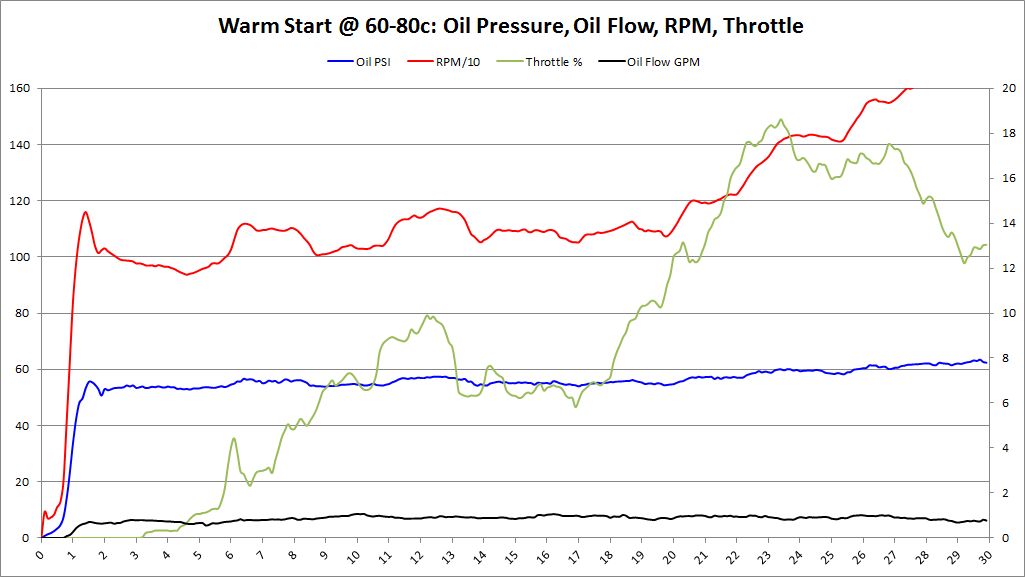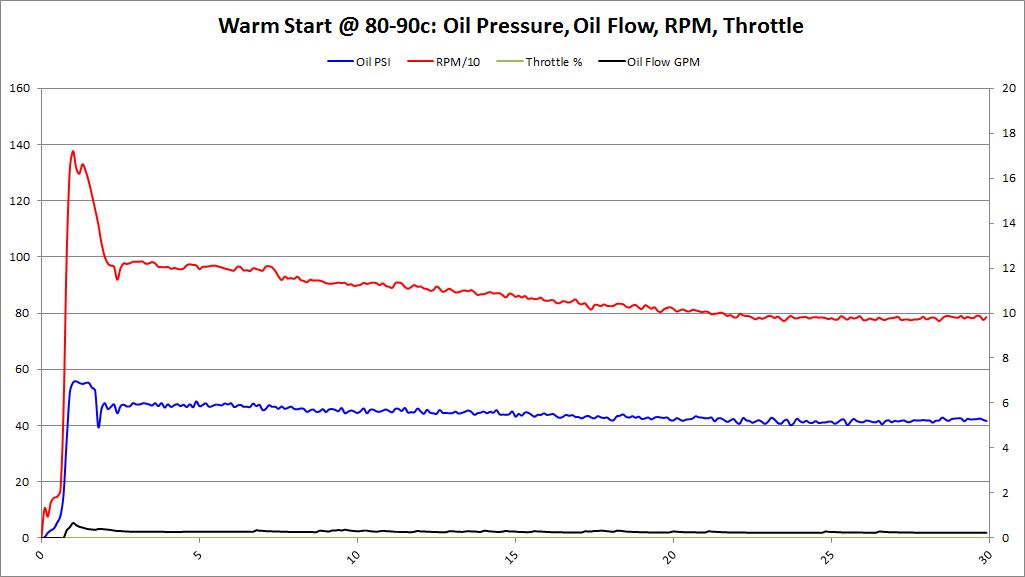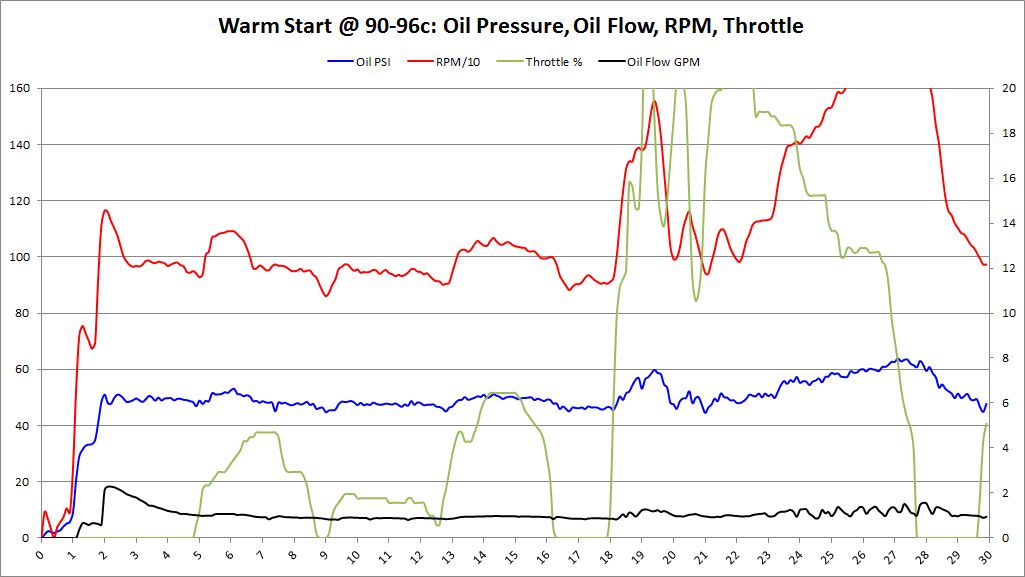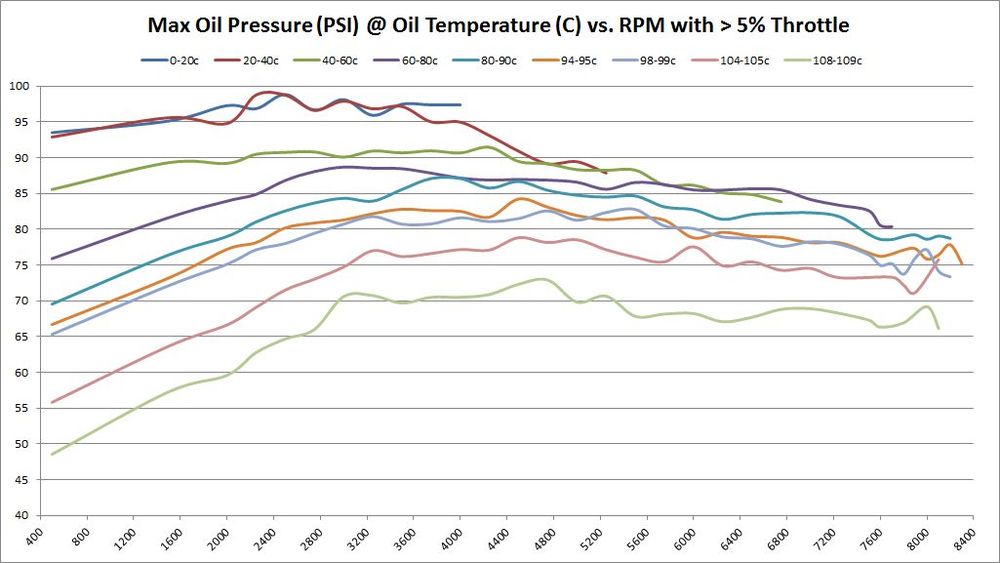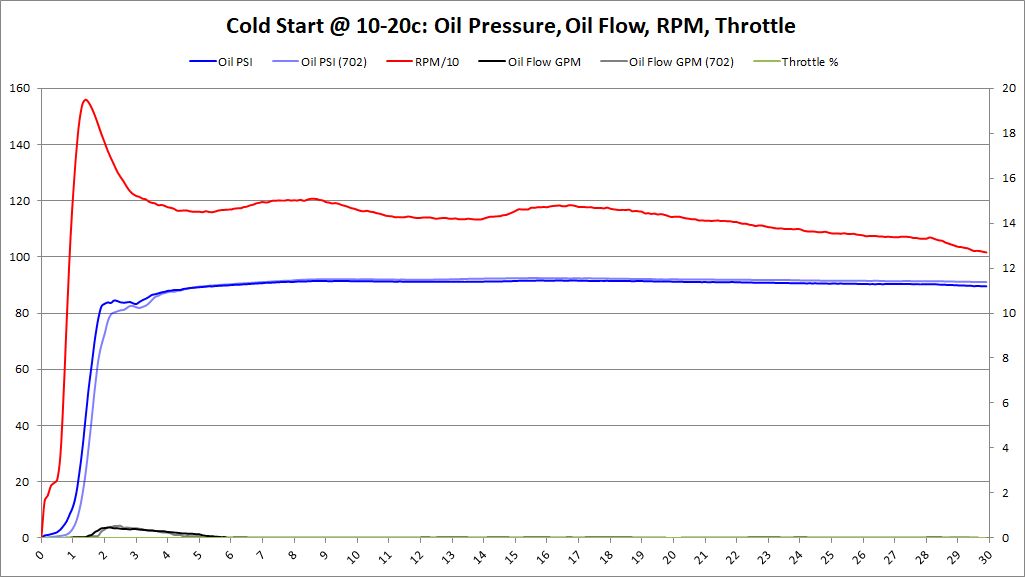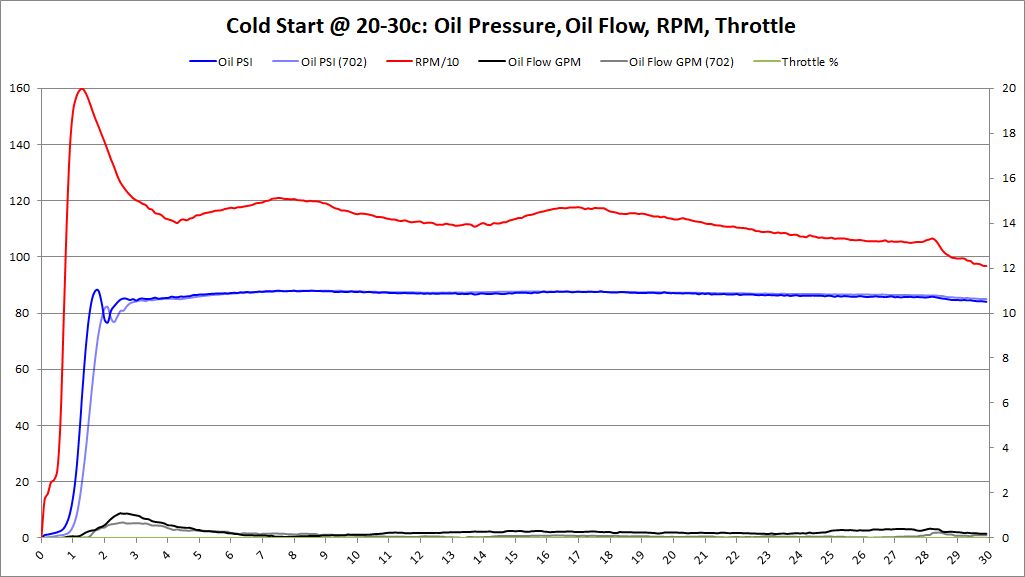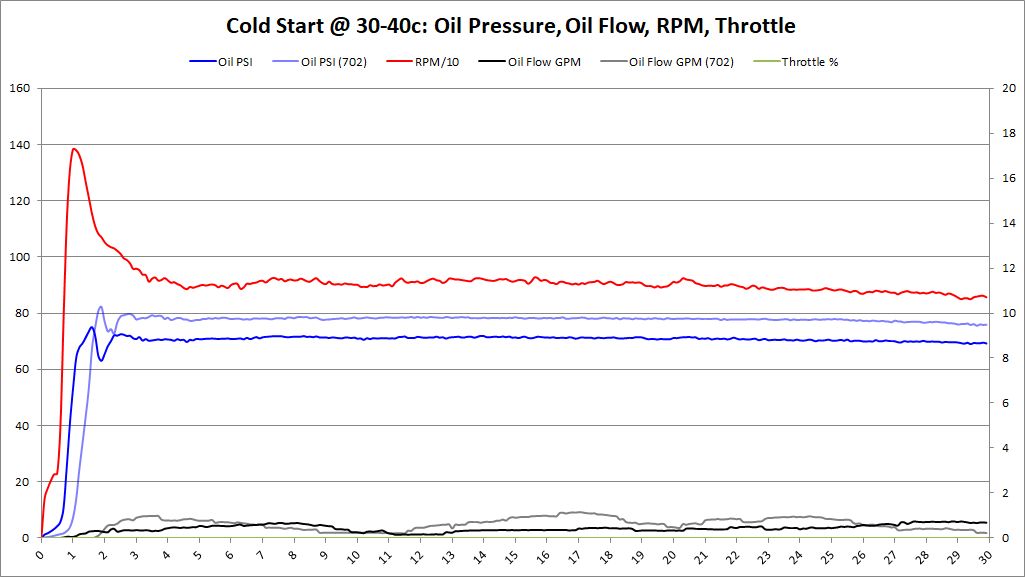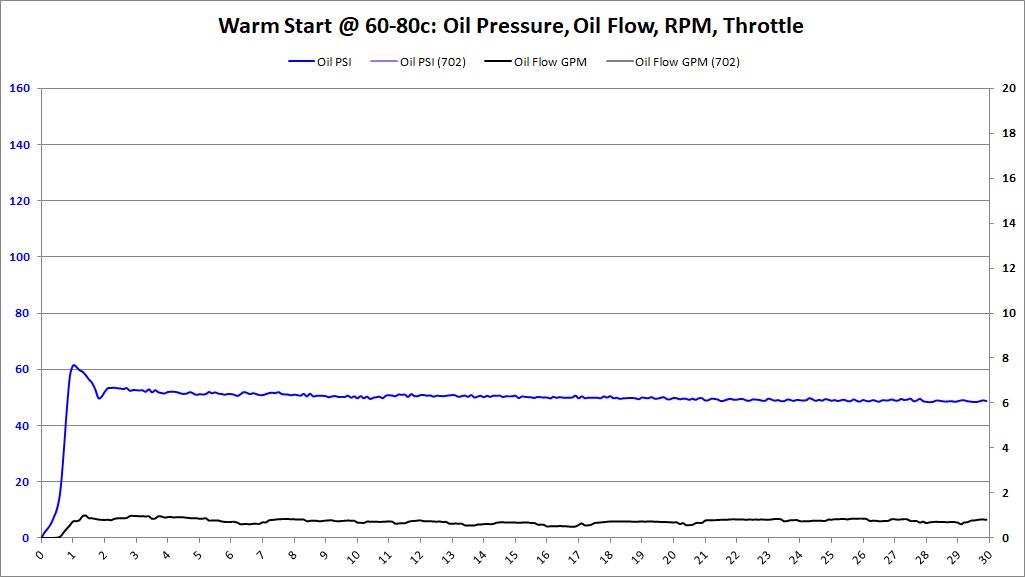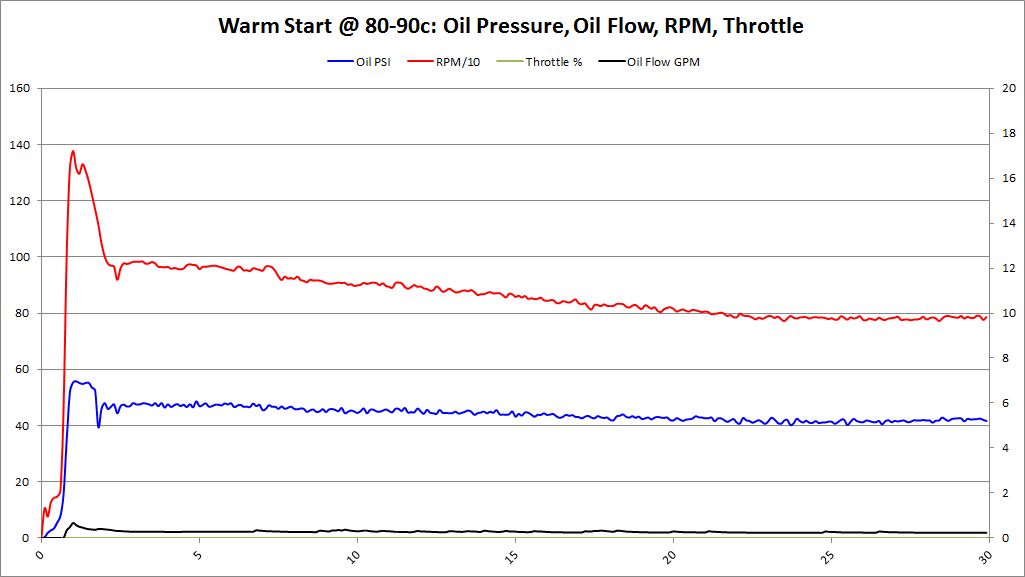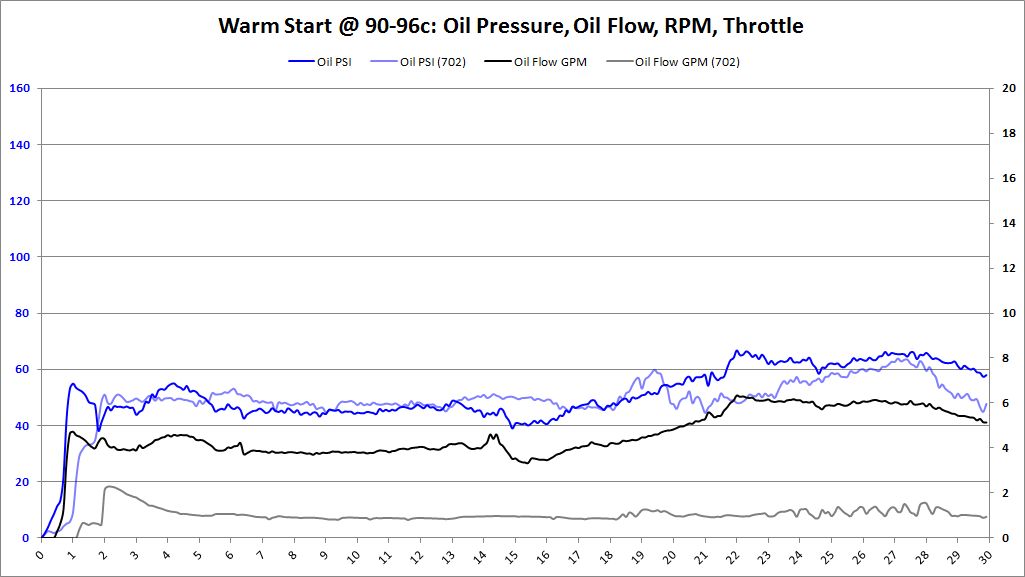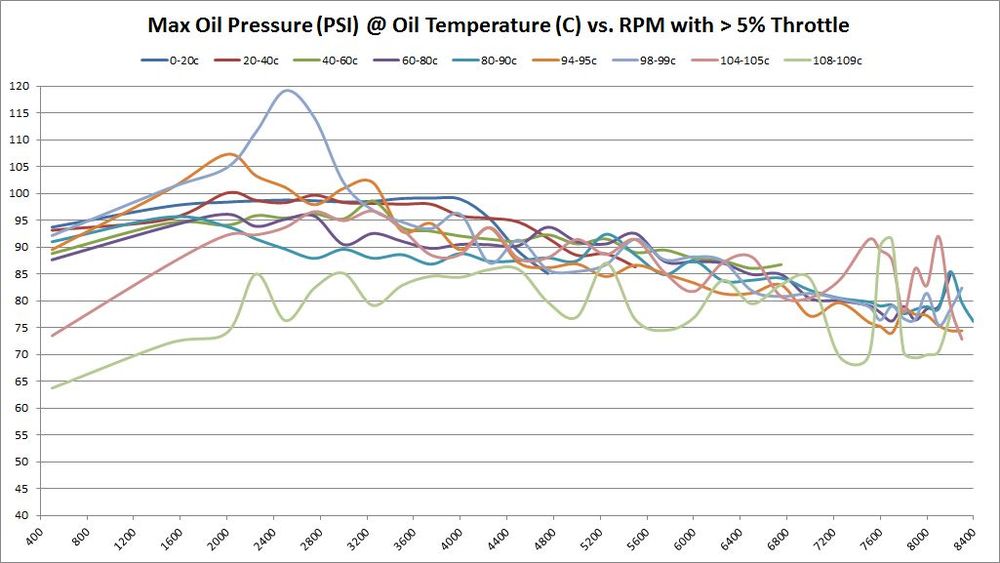Oil Flow - S65 Oil Flow Analysis: Difference between revisions
| Line 738: | Line 738: | ||
<p></p> | <p></p> | ||
==== Oil Flow Analysis ==== | |||
=====About Oil Flow===== | |||
Why do we measure oil flow? | |||
There are a few important reasons we measure oil flow. | |||
# Oil flow across the bearing surface is what keeps the bearings cool and reduces wear. When we change bearings from factory to BE Bearings with increased clearance, there may be a slight drop in oil pressure due to the larger bearing clearance. But oil pressure doesn’t tell the whole story. A modest decrease in oil pressure is not harmful; but we are hoping to see an increase in oil flow with BE Bearings. Establishing this baseline is important to BE Bearing analysis to see if the new bearings increase oil flow as hoped. | |||
# Expanding on (1) above, measuring oil flow is a good way to gauge the difference caused by BE Bearings. By testing on the same engine, with the same oil, with same driver, who drives under the same driving conditions, and who drives in the in the same style, oil pressure and oil flow (specifically oil flow) will be the primary measurement change between factory and BE Bearings. | |||
# As the engine heats up, the oil becomes less viscous. Increased oil flow is expected as the engine heats up. Since this data is totally unknown outside of BMW, we measure it and provide it for the community to share. | |||
=====Measuring Oil Flow===== | |||
Oil flow is measured with a Flow Technologies turbine flow meter between the engine oil filter outlet and oil cooler. This is the only place outside of the engine that the sensor could be placed. Oil flow to the cooler is thermostatically controlled. When the engine is cold, or just doesn’t feel like it, no oil is sent through the oil cooler – and thus not measured by the oil flow meter. Our programs used to measure and graph oil flow take this into account and ignore times when the thermostat is closed and not sending oil to the oil cooler. | |||
Oil flow in the S65 varies with temperature and RPM. Oil As you would expect, the higher the engine RPM, more oil flow will result. But a little less obvious, oil flow increases as the engine heats up. This is because the oil becomes less viscous with increased heat. | |||
===== How oil flow changes with different oil temperatures and RPM ===== | |||
These graphs show the oil flow average of all available samples at various temperatures and throttle ranges over RPM. The graphs do change slightly between 5%, 30%, and 50% throttle. The primary graph, 50% throttle is shown here. Click the thumbnails of the other graphs to enlarge each one. | |||
{| | |||
|[[File:Oil GPM vs RPM with 05 pct Throttle BEB.jpg|alt=Oil Flow (GPM) @ Oil Temperature (C) vs. RPM with > 5% Throttle|thumb|Oil Flow (GPM) @ Oil Temperature (C) vs. RPM with > 5% Throttle]] | |||
|rowspan="2"| [[File:Oil GPM vs RPM with 50 pct Throttle BEB.jpg|Thumb|900x900px|Oil Flow (GPM) @ Oil Temperature (C) vs. RPM with > 50% Throttle|Oil Flow (GPM) @ Oil Temperature (C) vs. RPM with > 50% Throttle]] | |||
|- | |||
|[[File:Oil GPM vs RPM with 30 pct Throttle BEB.jpg|alt=Oil Flow (GPM) @ Oil Temperature (C) vs. RPM with > 30% Throttle|thumb|Oil Flow (GPM) @ Oil Temperature (C) vs. RPM with > 30% Throttle]] | |||
|} | |||
Revision as of 00:38, 28 December 2016
Test Vehicle
- 2008 BMW M3
- 100% stock engine with 30000 miles
- Stock ECU
- Stock exhaust
Data logging Equipment
- Racelogic Video Vbox Pro, 32-channels engine (ECU) CAN bus.
- Racelogic Mini Input Module. Eight channels A-D conversions, transffered via CAN to Video VBox Pro
- AEM oil pressure sensor. 0-10 BAR; 0-5V analog output to Racelogic Mini Input Module
- Flow Technologies Turbine Oil Flow Sensor. Oil temperature and oil viscosity corrected. Calibrated for Castrol TWS 10W60 oil. 0-15 Gallons Per Minute (GPM); 0-10V analog output to Racelogic Mini Input Module.
Data signals collected and stored
- Timestamp (GMT)
- Vehicle Latitude
- Vehicle Longitude
- Vehicle Elevation (terrain height)
- Vehicle Velocity
- Wheel Speed Sensors (LF, RF, LR, RR)
- BMW internal speedometer
- Odometer
- Brake pedal pressure
- Steering angle
- Fuel gauge
- Vehicle voltage
- Engine RPM
- Throttle position (% open)
- Ambient pressure
- Ambient temperature
- Water temperature
- Oil temperature
- Oil Flow (0-15 GPM)
- Oil Pressure (0-150 PSI)
Testing Methods
Cold Starts
- Cold Start: Oil Temperature < 40 deg (C)
Each cold start was data logged. Data logger was powered up and obtained GPS signal. Once the GPS signal was locked, the data logging was started. After data logging started, the vehicle was started. This allowed the entire starting sequence, low RPMs with the starter, oil pressure, and oil flow to be tracked during the cold start procedure.
Warm Starts
- Warm Start: Oil Temperature > 40 deg (C)
Exact same procedure as cold starts, and for the same purpose. Data logger was powered up and obtained GPS signal. Once the GPS signal was locked, the data logging was started. After data logging started, the vehicle was started.
Everyday driving and hard cornering
Vehicle was driven as a daily driver. 27 miles to work in rush hour traffic each day. Hard corning when possible. Grocery getting and fast food runs when possible.
Attempt to hit max RPM whenever possible. This helps data log oil flow.
- Attempted to hit max RPM in 2nd gear each morning while getting on the freeway. This was my best and most consistent opportunity.
- Also hit max RPM whenever the opportunity presented itself. Starbucks runs on weekends were a good opportunity for a consistent high RPM runs on open road.
Track day driving
I would have liked to include at least one track day with each set of rod bearings, but that wasn’t possible. At the track day event with the factory 702/703 bearings, the car immediately went into limp mode on the first parade lap. We never were able to fix the issue on that day. It was eventually tracked down to bad seals on the throttle bodies and/or possible loose ground strap (both issues were present). Therefore, the track day never happened for the original 702/703 bearings.
Testing Results
BMW Factory 702/703 Bearings
Overview
| Distance Traveled | Metric (KM) | SAE (Miles) |
|---|---|---|
| Starting Odometer | 50007 | 31073 |
| Ending Odometer | 60548 | 37623 |
| Total | 10541 | 6550 |
| Statistics | |
|---|---|
| Number of files analyzed | 360 |
| Number of cold starts | 166 |
| Number of warm starts | 74 |
| Distance Traveled | 6550 Miles (10541 KM) |
| Data Log Entries (#) | 5115132 |
| Individual data items collected | 138108564 |
Cold/Warm Start Analysis
Cold/Warm Start Data
Once you start your car, have you ever wondered how long it takes for oil pressure to build and oil flow to start? This is the section that shows what it looks like.
The following chart amd graphs will show what it looks like from the time you press the "START" button to 30-seconds later. The chart shows how long from “START” until 70% and 90% oil pressure is attained. After analyzing some of the data, it appears the throttle input might have been influencing the maximum oil pressure and flow. Had I known this, I would have not introduced any throttle until 30+ seconds after starting the car.
| Temperature | 70% pressure (seconds) | 90% pressure (seconds) |
|---|---|---|
| 0-10c | 2.0 | 2.6 |
| 10-20c | 2.0 | 2.9 |
| 20-30c | 1.7 | 2.4 |
| 30-40c | 1.5 | 1.7 |
| 40-60c | 1.2 | 1.5 |
| 60-80c | 1.2 | 12.2 |
| 80-90c | 1.1 | 1.3 |
| 90-86c | 1.9 | 25.6 |
Cold Start Graphs
Warm Start Graphs
Oil Pressure Analysis
The factory oil pump is a variable displacement vane (variable pressure) oil pump.
| Metric (BAR) | SAE (PSI) | |
|---|---|---|
| Minimum oil pressure at idle | 1.0 | 14.50 |
| Minimum oil pressure while running | 4.0 – 6.0 | 58.0 – 87.0 |
Oil pressure in the S65 varies with temperature. This is expected because as the oil is colder, it is more viscous. As the oil heats up, it becomes less viscous and reduces the pressure. This graph shows the relationship between oil temperature and oil pressure. Each color band represents a different temperature. The temperature (color) bands range from 0-degrees C to 110-degrees C. They are plotted against the RPMs of the engine.
How oil pressure changes with different oil temperatures
These graphs show the oil pressure average of all 5.4 million samples at various temperatures and throttle ranges over RPM. The graphs do change slightly between 5%, 30%, and 50% throttle. The primary graph, 50% throttle is shown here. Click the thumbnails of the other graphs to enlarge each one.
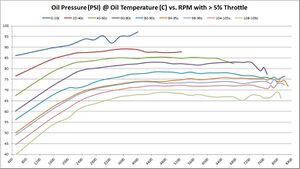 |
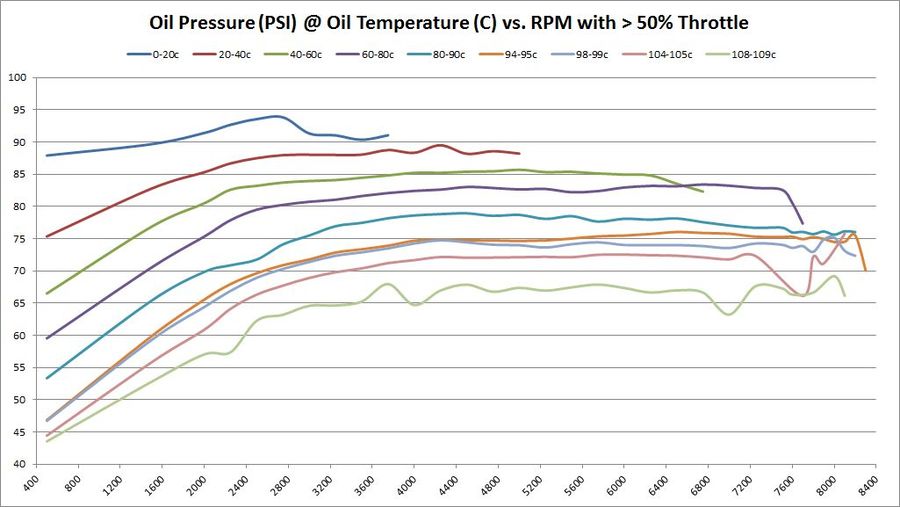
|
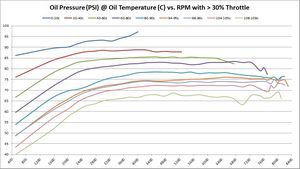 |
If minimum oil operating oils pressure is 4-BAR (58 PSI), then it’s interesting to see on this graph at what RPM that goal is achieved. Again, that answer depends on oil temperature – as oil is more viscous and produces more pressure the colder it is. As these graphs show, the minimum operating oil pressure at minimum RPM appears to be right around 2500; that’s where we get minimum 4-bar pressure regardless of oil temperature.
The following chart shows average oil pressure vs. RPM. It shows what RPM achieves minimum recommended 4-BAR (58-PSI) oil pressure.
| Average Oil Pressure @ RPM per Oil Temperature | 5% Throttle | 30% Throttle | 50% Throttle |
|---|---|---|---|
| 0-20c | 500 | 500 | 500 |
| 20-40c | 500 | 500 | 500 |
| 40-60c | 500 | 500 | 500 |
| 60-80c | 500 | 1500 | 500 |
| 80-90c | 1500 | 1500 | 1500 |
| 90-91c | 1500 | 1500 | 1500 |
| 92-93c | 1500 | 1500 | 1500 |
| 94-95c | 1500 | 1500 | 1500 |
| 96-97c | 1500 | 1500 | 1500 |
| 98-99c | 1500 | 1500 | 1500 |
| 100-101c | 1500 | 1500 | 2000 |
| 102-103c | 1500 | 2000 | 2000 |
| 104-105c | 2000 | 2000 | 2000 |
| 106-107c | 2000 | 2000 | 2000 |
| 108-109c | 2250 | 2250 | 2500 |
| 110-111c | 2500 | 2250 | 2250 |
Absolute minimum oil pressure with different oil temperatures
So far, the data being shown are averages across millions of samples. But what about absolute minimum and absolute maximums?
These are the same set of graphs as above, but show the absolute minimums. The absolute minimums are the minimum oil pressures collected across all temperature ranges. They are graphed here to show just how low the pressure can go. Some of this may have been observed during hard cornering (more on that later). So it's hard to draw any hard conclusions based on these graphs. They are offered for informational purposes only to let the reader draw their own conclusions.
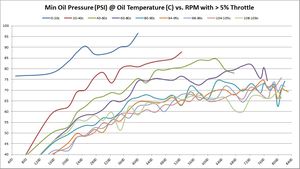 |
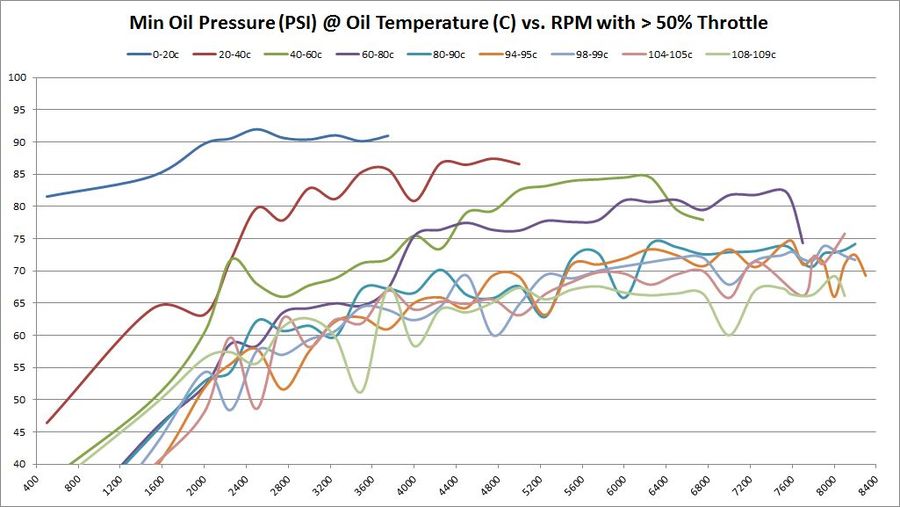
|
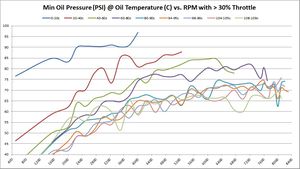 |
Absolute maximum oil pressure with different oil temperatures
Conversely, the final graph in this set shows the absolute maximums. There's no need to show maximum graphs for different throttle levels because the maximums are absolute and every graph would be the same.
Oil Flow Analysis
About Oil Flow
Why do we measure oil flow? There are a few important reasons we measure oil flow.
- Oil flow across the bearing surface is what keeps the bearings cool and reduces wear. When we change bearings from factory to BE Bearings with increased clearance, there may be a slight drop in oil pressure due to the larger bearing clearance. But oil pressure doesn’t tell the whole story. A modest decrease in oil pressure is not harmful; but we are hoping to see an increase in oil flow with BE Bearings. Establishing this baseline is important to BE Bearing analysis to see if the new bearings increase oil flow as hoped.
- Expanding on (1) above, measuring oil flow is a good way to gauge the difference caused by BE Bearings. By testing on the same engine, with the same oil, with same driver, who drives under the same driving conditions, and who drives in the in the same style, oil pressure and oil flow (specifically oil flow) will be the primary measurement change between factory and BE Bearings.
- As the engine heats up, the oil becomes less viscous. Increased oil flow is expected as the engine heats up. Since this data is totally unknown outside of BMW, we measure it and provide it for the community to share.
Measuring Oil Flow
Oil flow is measured with a Flow Technologies turbine flow meter between the engine oil filter outlet and oil cooler. This is the only place outside of the engine that the sensor could be placed. Oil flow to the cooler is thermostatically controlled. When the engine is cold, or just doesn’t feel like it, no oil is sent through the oil cooler – and thus not measured by the oil flow meter. Our programs used to measure and graph oil flow take this into account and ignore times when the thermostat is closed and not sending oil to the oil cooler.
Oil flow in the S65 varies with temperature and RPM. Oil As you would expect, the higher the engine RPM, more oil flow will result. But a little less obvious, oil flow increases as the engine heats up. This is because the oil becomes less viscous with increased heat.
How oil flow changes with different oil temperatures and RPM
These graphs show the oil flow average of all 5.4 million samples at various temperatures and throttle ranges over RPM. The graphs do change slightly between 5%, 30%, and 50% throttle. The primary graph, 50% throttle is shown here. Click the thumbnails of the other graphs to enlarge each one.
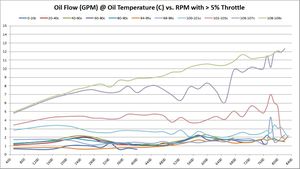 |
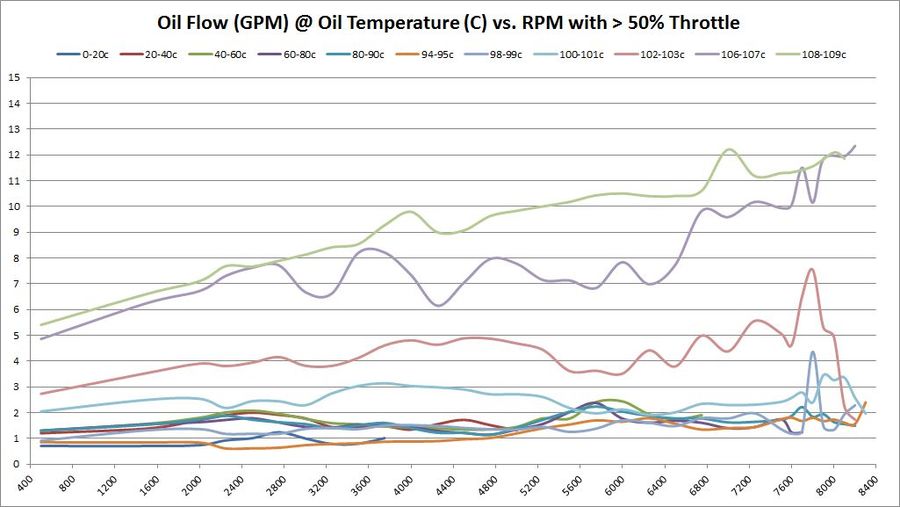
|
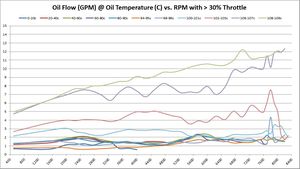 |
Summary Oil Pressure and Oil Flow
Average Oil Pressure and Oil Flow
So what is the best way to roll up all of the data, and view it as a single graph? To me, this was best achieved by limiting the operating temperatures to 98-120 degrees-C. We’ve seen how the S65 oil pressure and oil flow change with oil temperature and RPM. The oil flow graphs above show that oil flow stays relatively constant below 98c. At 98c, the oil pump has the most demands on it, and the oil thermostat is fully open. Even at 94-96c, I could see the oil thermostat closing for brief moments. This made 98-120c the best choice for rolling up all of the data. This will be one of the best comparisons against bigger clearance BE Bearings, as that data becomes available.
These graphs show the average oil pressure and average oil flow average of all samples between 98-119c, and throttle ranges over RPM. The graphs do change slightly between 5%, 30%, and 50% throttle. The primary graph, 50% throttle is shown here. Click the thumbnails of the other graphs to enlarge each one.
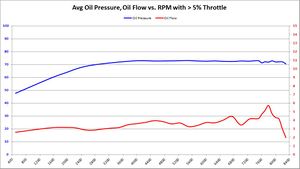 |
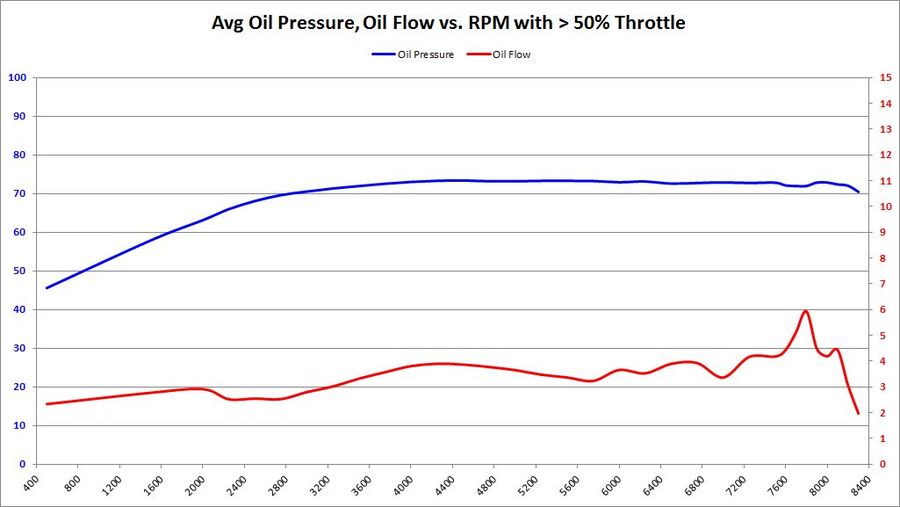
|
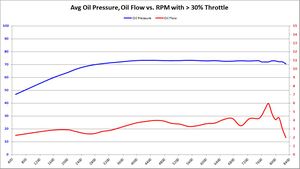 |
BE Bearings SP1527HK
Snapshot Date: 2016-11-30
Overview
| Distance Traveled | Metric (KM) | SAE (Miles) |
|---|---|---|
| Starting Odometer | 60557 | 37628 |
| Ending Odometer | 64902 | 40328 |
| Total | 4345 | 2700 |
| Statistics | |
|---|---|
| Number of files analyzed | 165 |
| Number of cold starts | 80 |
| Number of warm starts | 65 |
| Distance Traveled | 2700 Miles (4345 KM) |
| Data Log Entries (#) | 2417631 |
| Individual data items collected | 65276037 |
Cold/Warm Start Analysis
Cold/Warm Start Data
The following chart amd graphs will show what it looks like from the time you press the "START" button to 30-seconds later. The chart shows how long from “START” until 70% and 90% oil pressure is attained. After analyzing some of the data, it appears the throttle input might have been influencing the maximum oil pressure and flow. Had I known this, I would have not introduced any throttle until 30+ seconds after starting the car.
BE Bearings
| Temperature | 70% pressure (seconds) | 90% pressure (seconds) |
|---|---|---|
| 0-10c | 1.7 | 2.0 |
| 10-20c | 1.8 | 2.2 |
| 20-30c | 1.4 | 1.6 |
| 30-40c | 1.3 | 1.5 |
| 40-60c | 1.0 | 10.8 |
| 60-80c | 0.8 | 0.9 |
| 80-90c | 0.9 | 18.9 |
| 90-96c | 0.9 | 21.9 |
BMW Factory 702/703 Bearings
| Temperature | 70% pressure (seconds) | 90% pressure (seconds) |
|---|---|---|
| 0-10c | 2.0 | 2.6 |
| 10-20c | 2.0 | 2.9 |
| 20-30c | 1.7 | 2.4 |
| 30-40c | 1.5 | 1.7 |
| 40-60c | 1.2 | 1.5 |
| 60-80c | 1.2 | 12.2 |
| 80-90c | 1.1 | 1.3 |
| 90-86c | 1.9 | 25.6 |
Summary: According to this chart, the BE Bearings take less time to reach 70% and 90% oil pressure compared to their BMW OEM counterparts. Not only is it less time to reach full oil pressure, it seems significantly less time to reach full oil pressure. This is a bit of a shock to me and something I never expected to see.
Cold Start Graphs
Summary These graphs show both BE Bearing and BMW Factory bearings (as lighter colors). It's very clear from these graphs, that the oil pressure comes up faster with BE Bearings than BMW Factory bearings. Having oil pressure come up faster and lubricating the bearings is a huge benefit to reduce bearing wear and increase bearing longevity. This was an unexpected surprise that we didn't anticipate. The graphs also show no decrease in oil pressure over factory bearings. This should allay fears that increased clearance would decrease oil pressure, especially during this critical "Cold Start" time period.
Oil flow does seem to modestly increase as well. This was an anticipated outcome, but it's good to see it on the graphs.
Warm Start Graphs
Summary The trend with continues from our Cold Start graphs to our Warm Start graphs. Oil pressure comes up faster with BE Bearings than BMW factory bearings. Oil flow shows modest increases as well, but we'd say this is fairly inconclusive -- especially above 80c. Those graphs contained too much throttle input, and we think that contaminates the results. Now that we know this, we will see if we can filter out the results containing too much throttle, and moving forward will capture results without any throttle until 30-seconds has passed since starting the engine.
Oil Pressure Analysis
The factory oil pump is a variable displacement vane (variable pressure) oil pump.
| Metric (BAR) | SAE (PSI) | |
|---|---|---|
| Minimum oil pressure at idle | 1.0 | 14.50 |
| Minimum oil pressure while running | 4.0 – 6.0 | 58.0 – 87.0 |
Oil pressure in the S65 varies with temperature. This is expected because as the oil is colder, it is more viscous. As the oil heats up, it becomes less viscous and reduces the pressure. This graph shows the relationship between oil temperature and oil pressure. Each color band represents a different temperature. The temperature (color) bands range from 0-degrees C to 110-degrees C. They are plotted against the RPMs of the engine.
How oil pressure changes with different oil temperatures
These graphs show the oil pressure average of all available samples at various temperatures and throttle ranges over RPM. The graphs do change slightly between 5%, 30%, and 50% throttle. The primary graph, 50% throttle is shown here. Click the thumbnails of the other graphs to enlarge each one.
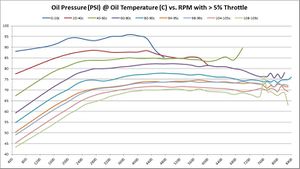 |
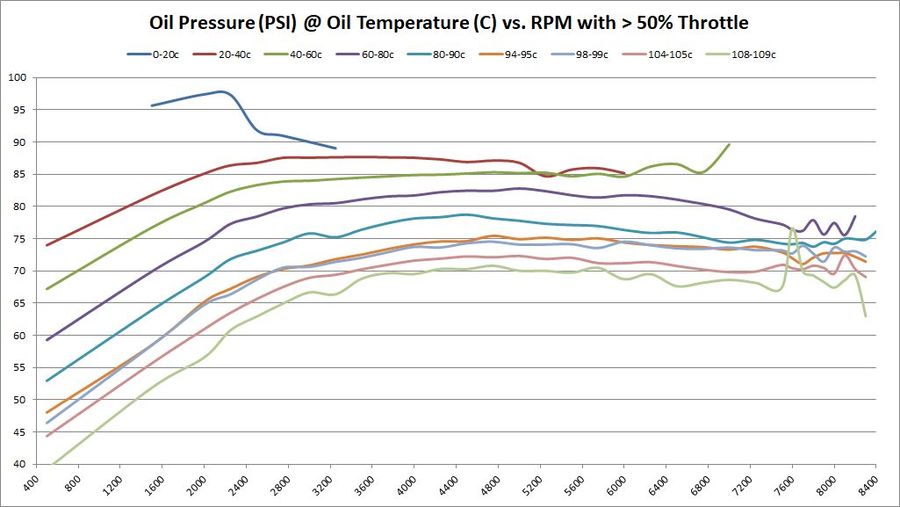
|
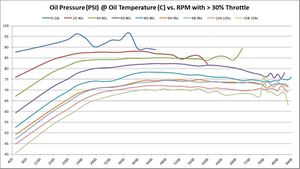 |
If minimum oil operating oils pressure is 4-BAR (58 PSI), then it’s interesting to see on this graph at what RPM that goal is achieved. Again, that answer depends on oil temperature – as oil is more viscous and produces more pressure the colder it is. As these graphs show, the minimum operating oil pressure at minimum RPM appears to be right around 2500; that’s where we get minimum 4-bar pressure regardless of oil temperature.
The following chart shows average oil pressure vs. RPM. It shows what RPM achieves minimum recommended 4-BAR (58-PSI) oil pressure. This chart compares to the BMW Factory bearings by color of text. Black text means the values are the same. Green text means the BE Bearings achieved minimum oil pressure at a lower RPM than factory bearings. Red text means the BE Bearings achieved minimum oil pressure at a higher RPM than factory bearings.
| Average Oil Pressure @ RPM per Oil Temperature | 5% Throttle | 30% Throttle | 50% Throttle |
|---|---|---|---|
| 0-20c | 500 | 500 | 500 |
| 20-40c | 500 | 500 | 500 |
| 40-60c | 500 | 500 | 500 |
| 60-80c | 500 | 500 | 500 |
| 80-90c | 1500 | 1500 | 1500 |
| 90-91c | 1500 | 1500 | 1500 |
| 92-93c | 1500 | 1500 | 1500 |
| 94-95c | 1500 | 1500 | 1500 |
| 96-97c | 1500 | 1500 | 2000 |
| 98-99c | 1500 | 1500 | 1500 |
| 100-101c | 1500 | 1500 | 1500 |
| 102-103c | 2000 | 2000 | 2000 |
| 104-105c | 2000 | 2000 | 2000 |
| 106-107c | 2000 | 2000 | 2000 |
| 108-109c | 2000 | 2000 | 2250 |
| 110-111c | 2000 | 2000 | 2250 |
Absolute minimum oil pressure with different oil temperatures
So far, the data being shown are averages across millions of samples. But what about absolute minimum and absolute maximums?
These are the same set of graphs as above, but show the absolute minimums. The absolute minimums are the minimum oil pressures collected across all temperature ranges. They are graphed here to show just how low the pressure can go. Some of this may have been observed during hard cornering (more on that later). So it's hard to draw any hard conclusions based on these graphs. They are offered for informational purposes only to let the reader draw their own conclusions.
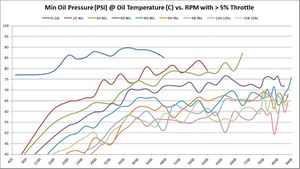 |
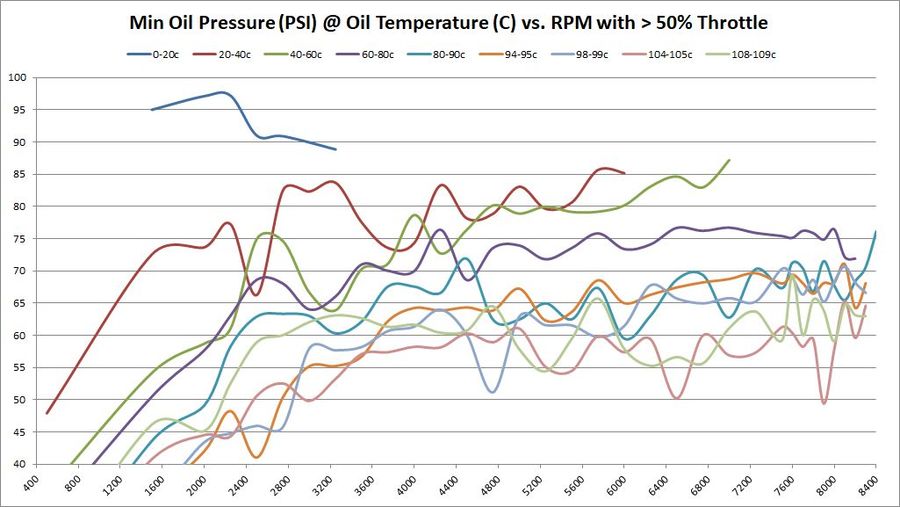
|
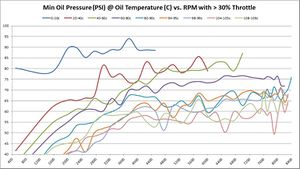 |
Absolute maximum oil pressure with different oil temperatures
Conversely, the final graph in this set shows the absolute maximums. There's no need to show maximum graphs for different throttle levels because the maximums are absolute and every graph would be the same.
Oil Flow Analysis
About Oil Flow
Why do we measure oil flow? There are a few important reasons we measure oil flow.
- Oil flow across the bearing surface is what keeps the bearings cool and reduces wear. When we change bearings from factory to BE Bearings with increased clearance, there may be a slight drop in oil pressure due to the larger bearing clearance. But oil pressure doesn’t tell the whole story. A modest decrease in oil pressure is not harmful; but we are hoping to see an increase in oil flow with BE Bearings. Establishing this baseline is important to BE Bearing analysis to see if the new bearings increase oil flow as hoped.
- Expanding on (1) above, measuring oil flow is a good way to gauge the difference caused by BE Bearings. By testing on the same engine, with the same oil, with same driver, who drives under the same driving conditions, and who drives in the in the same style, oil pressure and oil flow (specifically oil flow) will be the primary measurement change between factory and BE Bearings.
- As the engine heats up, the oil becomes less viscous. Increased oil flow is expected as the engine heats up. Since this data is totally unknown outside of BMW, we measure it and provide it for the community to share.
Measuring Oil Flow
Oil flow is measured with a Flow Technologies turbine flow meter between the engine oil filter outlet and oil cooler. This is the only place outside of the engine that the sensor could be placed. Oil flow to the cooler is thermostatically controlled. When the engine is cold, or just doesn’t feel like it, no oil is sent through the oil cooler – and thus not measured by the oil flow meter. Our programs used to measure and graph oil flow take this into account and ignore times when the thermostat is closed and not sending oil to the oil cooler.
Oil flow in the S65 varies with temperature and RPM. Oil As you would expect, the higher the engine RPM, more oil flow will result. But a little less obvious, oil flow increases as the engine heats up. This is because the oil becomes less viscous with increased heat.
How oil flow changes with different oil temperatures and RPM
These graphs show the oil flow average of all available samples at various temperatures and throttle ranges over RPM. The graphs do change slightly between 5%, 30%, and 50% throttle. The primary graph, 50% throttle is shown here. Click the thumbnails of the other graphs to enlarge each one.
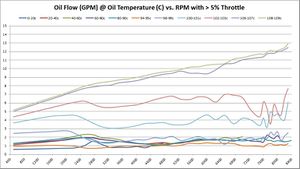 |
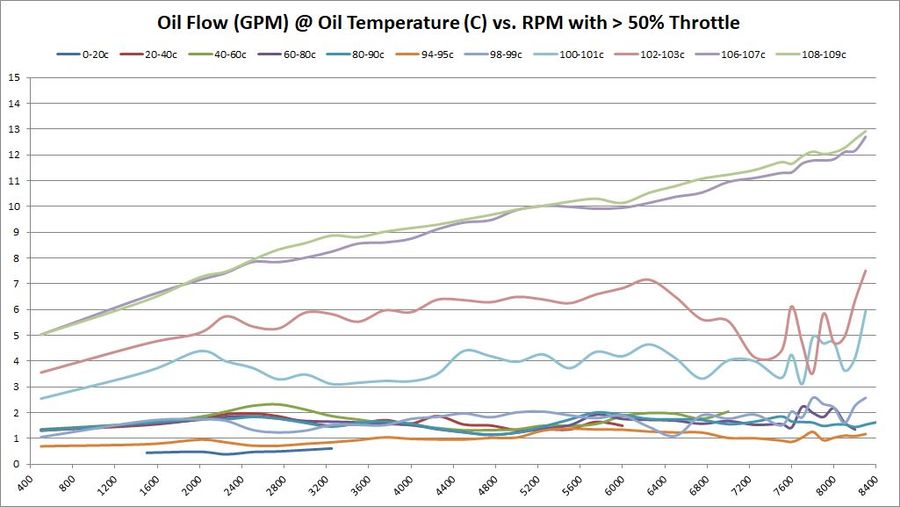
|
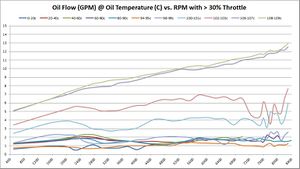 |

